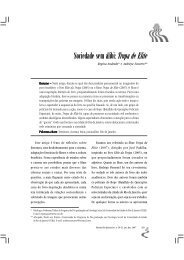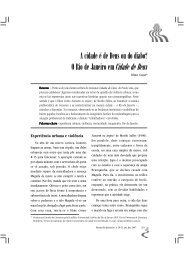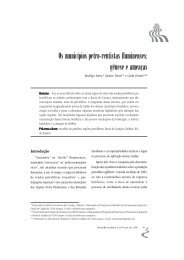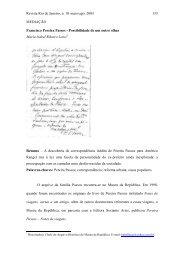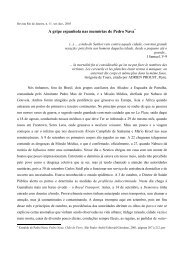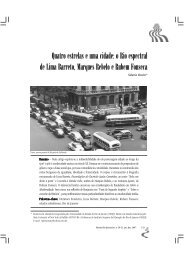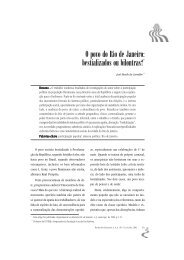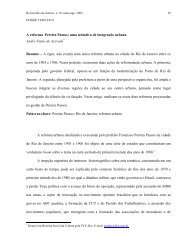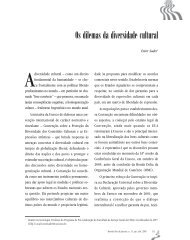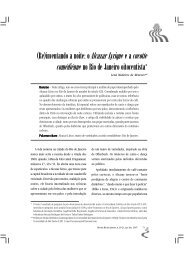Conflitos ambientais no Parque Natural Municipal de Grumari
Conflitos ambientais no Parque Natural Municipal de Grumari ...
Conflitos ambientais no Parque Natural Municipal de Grumari ...
You also want an ePaper? Increase the reach of your titles
YUMPU automatically turns print PDFs into web optimized ePapers that Google loves.
<strong>Conflitos</strong> <strong>ambientais</strong> <strong>no</strong> <strong>Parque</strong> <strong>Natural</strong> <strong>Municipal</strong> <strong>de</strong> <strong>Grumari</strong><br />
Abstract – Environmental conflicts mirror a classification struggle for the most legitimate<br />
representation of nature and for power distribution over territory-circumscribed natural<br />
resources. The concept of conservation unit ascribes qualities to certain territorial<br />
stretches, which legitimate restrictions to their use via legal tools and impose a<br />
representation which may differ from those claimed by local populations. This essay<br />
aims at looking over the set of representations involved in the conflicted legitimization<br />
of several forms of territory appropriation in the <strong>Grumari</strong> Park, which houses populations<br />
long residing and working there. We expect to contribute to a <strong>de</strong>mocratic treatment of<br />
environmental conflicts on behalf of the whole set of social actors involved.<br />
Keywords: environmental conflicts; nature; conservation unit; Rio <strong>de</strong> Janeiro.<br />
Resumen – Los conflictos ambientales expresan una lucha clasificatoria por la<br />
representación más legítima <strong>de</strong> la naturaleza y por la distribución <strong>de</strong> po<strong>de</strong>r sobre los<br />
recursos naturales territorializados. El concepto <strong>de</strong> unidad <strong>de</strong> conservación atribuye<br />
a <strong>de</strong>terminadas partes <strong>de</strong> un territorio condiciones que justifican limitaciones <strong>de</strong> su<br />
uso, por medio <strong>de</strong> instrumentos jurídicos, que imputan una <strong>de</strong>terminada<br />
representación <strong>de</strong> territorio natural, que se pue<strong>de</strong> <strong>de</strong>rivar <strong>de</strong> las representaciones<br />
involucradas en la legitimación conflictiva <strong>de</strong> las distintas formas <strong>de</strong> apropiación <strong>de</strong>l<br />
territorio en el <strong>Parque</strong> <strong>de</strong> <strong>Grumari</strong>, que alberga poblaciones que tradicionalmente<br />
habitan y trabajan en el local, con el <strong>de</strong>signio <strong>de</strong> favorecer el tratamiento <strong>de</strong>mocrático<br />
<strong>de</strong> los conflictos ambientales por los actores sociales involucrados.<br />
Palabras-clave: conflictos ambientales; naturaleza; unidad <strong>de</strong> conservación; medio<br />
ambiente; Río <strong>de</strong> Janeiro.<br />
Notas<br />
1<br />
Constituem o Grupo das Unida<strong>de</strong>s <strong>de</strong> Proteção Integral: Estação Ecológica, Reserva Biológica, <strong>Parque</strong> Nacional (Estadual ou<br />
<strong>Natural</strong> <strong>Municipal</strong>), Monumento <strong>Natural</strong> e Refúgio da Vida Silvestre.<br />
2<br />
O Grupo das Unida<strong>de</strong>s <strong>de</strong> Uso Sustentável é composto pelas seguintes categorias: Área <strong>de</strong> Proteção Ambiental, Área <strong>de</strong> Relevante<br />
Interesse Ecológico, Floresta Nacional, Reserva Extrativista, Reserva da Fauna, Reserva <strong>de</strong> Desenvolvimento Sustentável e Reserva<br />
Particular do Patrimônio <strong>Natural</strong>. A pesquisa científica, a visitação pública e a educação ambiental também po<strong>de</strong>m ser <strong>de</strong>senvolvidas<br />
nessas unida<strong>de</strong>s, <strong>de</strong> acordo com o regulamento da unida<strong>de</strong> e seu Pla<strong>no</strong> <strong>de</strong> Manejo.<br />
3<br />
As fontes documentais utilizadas na pesquisa constituem: processos administrativos e judiciais, abaixo-assinados, ofícios, memorandos<br />
e encaminhamentos administrativos <strong>de</strong> órgãos estaduais e municipais.<br />
4<br />
O percentual das “áreas <strong>de</strong> floresta” foi obtido a partir do somatório <strong>de</strong> duas tipologias mais específicas: “floresta” e “floresta<br />
alterada”. A primeira refere-se às áreas ocupadas pela floresta ombrófila <strong>de</strong>nsa (Mata Atlântica) pouco alterada ou não alterada,<br />
po<strong>de</strong>ndo representar também uma floresta secundária tardia, em estágio avançado <strong>de</strong> regeneração. A segunda classificação “inclui<br />
diversas fitofisio<strong>no</strong>mias associadas à alteração das florestas nativas, como raleamento por corte seletivo ou pequenas áreas <strong>de</strong><br />
<strong>de</strong>smatamento, além <strong>de</strong> associadas às diversas fases sucessionais que seguem a supressão total ou parcial da floresta nativa (em<br />
Revista Rio <strong>de</strong> Janeiro, n. 16-17, maio-<strong>de</strong>z. 2005 131



